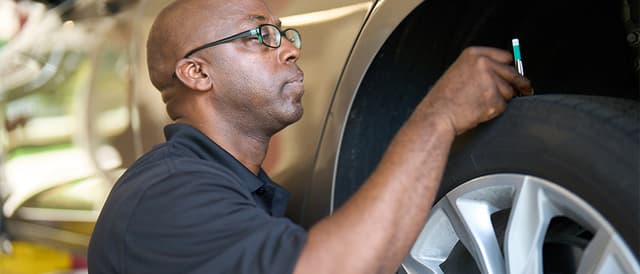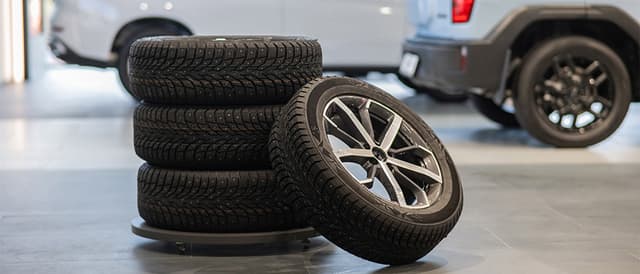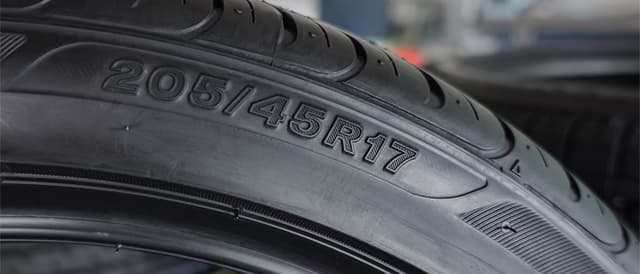How to Check Tire Tread Depth
By Mavis Tire Team
Published 04/30/2025

Somewhere in every community, there's that one traffic light. The one on the hill. The one nobody wants to get stopped at when the road conditions are slick and slippery. You may have even witnessed someone stuck there. The light turns green, the wheels spin, and they go nowhere. Or worse, they start sliding sideways or backward. Not only is that not fun, but it can also be scary and dangerous.
We want our customers to drive confidently at Mavis Tires and Brakes. So, let’s discuss tire tread.
We’ll explain tire tread, why it’s essential, and how to check tire tread depth.
Proudly serving the community for over 70 years, Mavis Tires and Brakes are built on a foundation of providing outstanding customer service. We offer your area's fastest, friendliest, and most affordable tire repair and replacement. At the first sign of tire trouble, head to your local Mavis.
What Is Tire Tread Depth?
Tire tread depth measures the vertical depth from the top of the tire’s rubber to the bottom of the lowest groove.
Tread is the rubber of a tire that makes contact with the surface you’re driving along and is responsible for traction. Traction gets your car moving and provides resistance for stopping. Traction is how well a tire grips the road’s surface. It’s normal for tire tread to wear down as we drive. The friction created by driving causes tread wear. Rough road surfaces, potholes, and hard braking also contribute.
Tire tread depth is crucial because as the tread wears down, you start losing traction. That’s why paying attention to tire tread depth and knowing how to check tire tread are crucial. Driving on tires with bad traction can become an incredibly slippery slope.
The Consequences of Driving on Tires With No or Low Tread
Your tire tread is literally where the rubber meets the road.
If you’ve ever had to slam on your brakes to avoid hitting something—the car in front of you or the neighbor's cat—you understand that even a few feet can be the difference between relief and an unfortunate event. Even if you’ve recently had your brakes replaced, your stopping power can be undermined by the condition of your tires.
Tires with insufficient tread depth are seriously hazardous to you, passengers, drivers, and pedestrians.
Some facts about tires with low tread:
Tires with low tread are more likely to hydroplane on wet road surfaces.
Tires with low tread are much more vulnerable to punctures and blowouts.
Low tire tread makes gaining traction on snow-covered or icy roads difficult.
Tires with low treads reduce a vehicle’s ability to stop effectively in all road conditions.
According to field-tested data from the American Automobile Association (AAA), when traveling at 60 mph, vehicles with worn tires needed an additional 87 feet on average to come to a complete stop compared to the same vehicle (at the same speed) with new tires. Plus, the vehicle with worn tires was still moving at 38.8 mph at the same point the new-tired vehicle was able to stop.
How to Check Tire Tread Depth
There are several simple ways to measure tire tread depth. The first three are easy DIY methods. They’re about as easy as digging out a handful of spare change from under the couch cushions. Just make sure you grab a quarter and a penny.
The Colin Tire Test:
A penny is typically used to measure tire tread depth. The penny test is a simple way to check if your tires have enough tread depth. Here's how it works:
Take a penny and hold it between your thumb and forefinger so Lincoln's head faces you.
Insert the penny into the tire tread with Lincoln's head upside down and facing you.
If you can see all of Lincoln's head, your tire tread depth is less than 2/32 of an inch, which means it's time to replace your tires.
If part of Lincoln's head is covered by the tread, your tires still have adequate tread depth.
Some people use a quarter for more precision. The exact process applies but with Washington's head. If the tread touches Washington's head, you have at least 4/32 of an inch of tread depth remaining.
Tire Tread Depth Gauge:
Although it costs more than a quarter, a tire tread depth gauge is an inexpensive tool to check tire tread depth.
A standard tire tread depth gauge measures 32nds of an inch in increments. Insert the probe bar into a groove and slide the flared shoulders down until they’re flush with the tread on either side. The measurement at the top of the gauge is your tire tread depth.
Pro Tip: When checking tread depth, make sure to check the tread on all four tires and several different areas on each tire.
How do you check tire tread depth without doing it yourself? There are two simple ways.
Tread Wear Indicator Bars
Most new tires have tread wear indicator bars built in. These indicators are raised rubber bars embedded in the tire’s grooves. Typical wear bars are 2/32 inches tall. When your tire tread wears down to the point that the wear bars are flush with the tread, it’s time to replace your tires.
Professional Tire Tread Check
If you’re not sure your tire tread depth is in good condition, it’s a good idea to get the opinion of Mavis, your local tire care specialist. Or maybe you’re not the DIY type and would leave it to the professionals? Either way, a full inspection can be done quickly and efficiently when choosing Mavis. Schedule an appointment today.
Tire Tread FAQs
How accurate is the penny test for tire tread depth?
Every penny minted has the exact dimensions. The distance from the edge of a penny to the top of Lincoln’s head is precisely 2/32 inches. This is why the penny test is an accurate measure. But, driving is very unsafe when the tire tread gets that low. For that reason, most experts feel the penny test is outdated. The quarter test is a better and safer measure of tire tread depth.
What is the limit for tread depth?
In the U.S., tire tread depth is measured in 32nds of an inch. The standard tread depth for new tires is 10/32 inches or 11/32 inches. Specialized off-roading and winter tires may have deeper tread depths.
Tires with 2/32 inches of tread depth or less must be replaced immediately. Most states and trusted tire manufacturers recommend replacement when the tread depth reaches 4/32 inches.
How often should I check my tire tread?
The National Highway Traffic Safety Administration (NHTSA)—a division of the U.S. Department of Transportation (DOT)—recommends checking your tire's tread at least once a month, at the same time you check your tire pressure.
What should I do if my tire tread is too low?
You may notice signs of uneven wear once you’ve learned how to check tire tread correctly. Maybe the tread depth is lower in some areas than in others. Sometimes, simply having your tires rotated can help extend the life of your tires.
Of course, if your tread is too low, the best option is to visit your local Mavis.
Get New Tires at Mavis Tires and Brakes
Tire wear is unavoidable. As your tire tread wears, tires become less effective, reducing traction. When the tread depth reaches 4/32 inch, it’s time to start planning to get new tires.
When you know it’s time for a new set of tires, you need tire experts you can trust. When you want superior customer service and first-rate tire repair service, visit Mavis Tires and Brakes. After many years of providing customers with a great experience, we’ve built a reputation you can trust.
As one of the largest independent multi-brand tire dealers in the U.S., we offer great deals on tires. With generous manufacturer rebates, tire promotions, and special offers, we have the right tires at the right price.
Read Next
Our in house tire experts are always available to help you find a great tire.

Our in house tire experts are always available to help you find a great tire.




